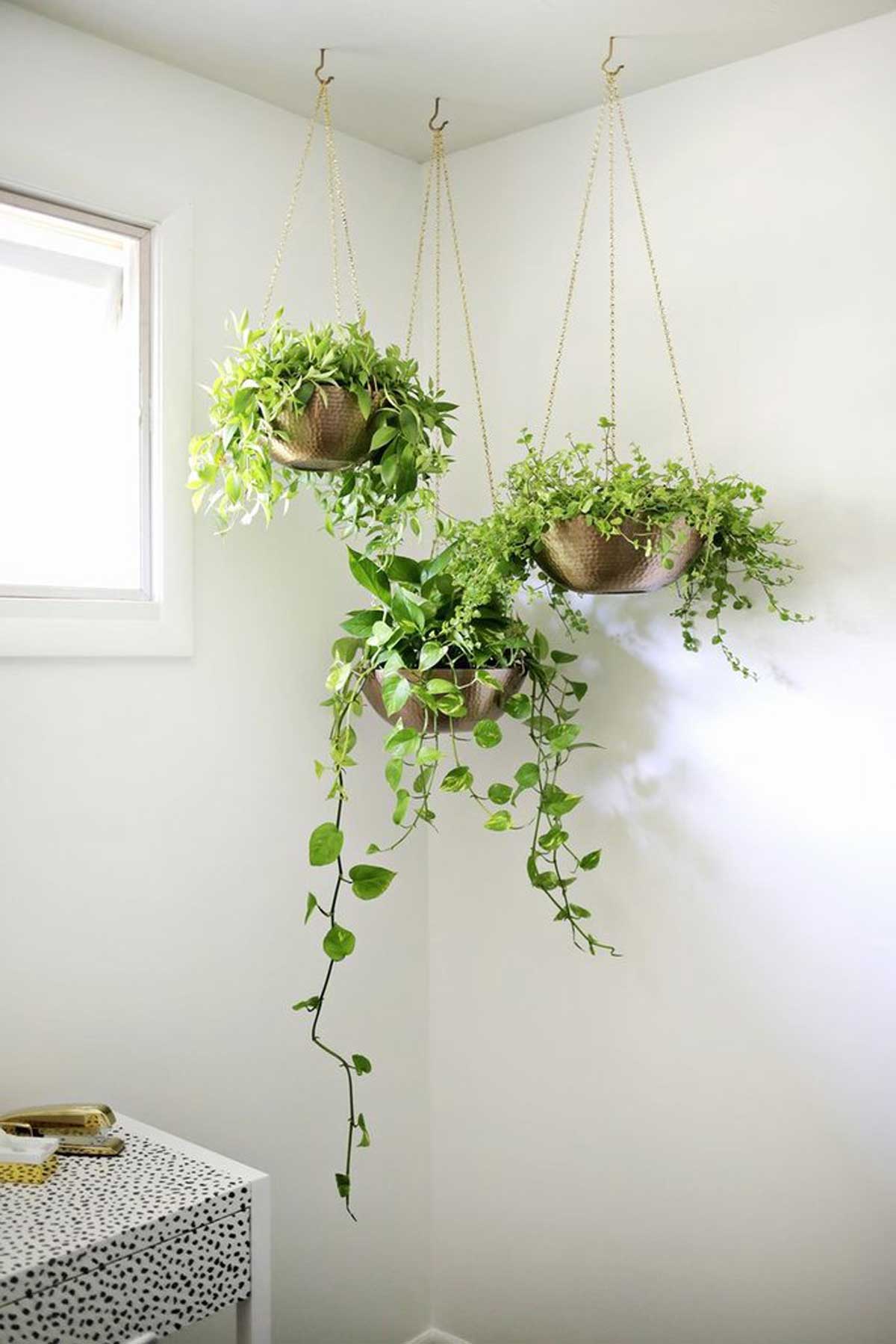Welcome to the incredible world of small indoor plants, where lush greenery and space-saving solutions meet in perfect harmony. Whether you’re an experienced plant whisperer or just starting to bring nature into your home, this guide will help you choose, care for, and style these compact plant pals like a pro. So, let’s dive right in and explore the secret lives of small indoor plants!
Choosing Your Perfect Green Companion
We all know that feeling – that longing for a little bit of nature, especially when we’re stuck inside. Well, guess what? You don’t need a sprawling garden to enjoy the benefits of greenery. Small indoor plants are like tiny superheroes, bringing life and joy to your home without taking over your living space.
Finding the Right Plant for Your Lifestyle
Before you run off to the nearest plant shop, let’s talk about finding the right small indoor plant for your lifestyle. It’s like finding a roommate – you want someone (or something, in this case) that fits in!
- The Busy Bee: If you’re always on the go, low-maintenance plants like the Snake Plant, ZZ Plant, or Peace Lily are your new best friends. They’re practically pros at taking care of themselves.
- The Shade Dweller: Don’t worry if your home doesn’t have tons of natural light. Aspidistra (also known as the “Cast Iron Plant” – a hint to its resilience!), Chinese Evergreen, and Philodendrons are quite content with a bit of shade.
- The Color Enthusiast: For a pop of personality, look no further than Jade Plants, Pothos (the trailing variety is stunning!), or Peperomias – they come in a range of vibrant colors and interesting leaf patterns.
Plant Parenting 101: Essential Care Tips
The good news? Small indoor plants are generally easy to care for. Here are a few key tips:
- Let There Be (Indirect) Light: Most small indoor plants prefer bright, indirect light. Think of it like a gentle sunbath rather than a scorching desert sun.
- Water Wisely: Overwatering is a common plant-parent pitfall. Instead of sticking to a strict schedule, check the soil moisture. When the top inch or so feels dry, it’s time to give your green buddy a drink. A moisture meter can be your new secret weapon!
- Food for Thought: Just like us, plants need nutrients! Fertilize your small indoor plants monthly during the growing season (spring and summer) to keep them happy and healthy.
- A Little Trim Goes a Long Way: Regularly trim away any dead or damaged leaves to keep your plant looking its best and to redirect its energy to new growth.
Styling Your Space: Unleash Your Inner Decorator
Now for the fun part – incorporating your small indoor plants into your home décor. Don’t be afraid to get creative!
- Classic Charm: Windowsills, bookcases, and side tables are perfect spots for a touch of green.
- Hanging Out: Macrame hangers instantly add a bohemian vibe and are perfect for trailing plants.
- Vertical Gardens: Short on space? No problem! Create a stunning vertical garden using shelves to display your plant collection.
- Mix and Match: Don’t be afraid to experiment with different sizes, shapes, and textures to create a visually interesting display.
Beyond Aesthetics: Reaping the Benefits
Beyond their aesthetic appeal, small indoor plants offer a surprising number of benefits:
- Natural Air Purifiers: They act like little green filters, removing toxins and improving the air quality in your home.
- Stress Busters: Studies suggest that being around plants can reduce stress levels and promote relaxation. Looking at your plant pal after a long day? Instant mood booster!
- Focus Power: Having small indoor plants around might actually help improve concentration and productivity. So, if you’re working from home, consider adding a few to your workspace.
- Humidity Helpers: Small indoor plants release moisture into the air, increasing humidity levels, which can benefit your skin and respiratory system, especially during dry winter months.
In a nutshell, incorporating small indoor plants into your home is one of the simplest and most rewarding things you can do for yourself and your living space. They bring joy, purify the air, and add a touch of life to even the most urban of jungles.
Beyond Cute: The Ultimate Guide to Houseplants That Stay Small
If you are running out of space in your home or apartment, why not try out a small house plant to light up that empty corner?
Forget the fear of outgrowing your space – discover the world of houseplants that thrive while staying compact. While most houseplants are naturally programmed to grow, some stay smaller for longer periods due to their growth habits or can be maintained at a smaller size with minimal pruning.
Choosing Long-Term Companions: Slow Growers and Compact Cultivars
Several plant types fit the “small houseplant” bill, offering a variety of options to suit your style:
- Slow-Growing Varieties: These plants naturally take longer to increase in size. Some popular choices include certain succulents, ZZ plants, and cast iron plants.
- Compact Cultivars: These are specifically bred to stay smaller than their standard counterparts. Look for names like ‘Compacta’ or ‘Mini’ when selecting plants.
- Pruning-Tolerant Species: Some plants handle pruning well, allowing you to manage their size without harming their health. Popular examples include spider plants and pothos.
Popular Small Houseplants to Brighten Your Space
Here are a few popular small houseplants that are likely to catch your eye:
- Lucky Bamboo: Despite its name, Lucky Bamboo is not a true bamboo but a type of dracaena. It’s known for its ability to grow in water or soil and its tolerance for low light conditions.
- Lithops (Living Stones): These fascinating succulents resemble pebbles or small stones, making them a unique addition to any plant collection. They require very little water and prefer bright, indirect light.
- Chinese Money Plant: This trending plant is said to bring good luck and prosperity. It’s relatively easy to care for and can tolerate a range of light conditions, though it prefers bright, indirect light.
- Baby Toes Succulent: This adorable succulent gets its name from its small, toe-shaped leaves. It’s drought-tolerant and prefers bright light.
- Spider Plant: Spider plants are known for their air-purifying qualities and their ability to produce “spiderettes” – baby spider plants that dangle from the mother plant. They’re relatively easy to care for and can tolerate a range of light conditions.
- Purple Shamrock: This unique plant features triangular, purple leaves that fold up at night. It prefers bright, indirect light and slightly moist soil.
- Polka Dot Plant: This eye-catching plant features brightly colored leaves with distinctive polka dots. It prefers bright, indirect light and well-draining soil.
- Kalanchoe: Kalanchoes are known for their colorful, long-lasting blooms. They prefer bright light and well-draining soil.
- Echeveria: Echeverias are a type of succulent that comes in a wide variety of colors and shapes. They’re drought-tolerant and prefer bright light.
- String of Pearls Succulent: This unique succulent features cascading stems with small, pearl-like leaves. It’s drought-tolerant and prefers bright, indirect light.
- Donkey’s Tail Succulent: Similar to the String of Pearls, this succulent has trailing stems with teardrop-shaped leaves. It’s drought-tolerant and prefers bright, indirect light.
Small Plants, Big Impact: Benefits Galore
Don’t let their size fool you – these petite powerhouses offer a range of benefits:
- Perfect for Small Spaces: Ideal for apartments, dorm rooms, or anyone with limited space.
- Easy to Care For: Many small houseplants are low-maintenance, making them a good choice for beginners.
- Can Purify the Air: Like their larger counterparts, small houseplants can contribute to cleaner indoor air.
Caring for Your Small Wonders
Providing the right care is essential for keeping your small houseplants healthy and thriving:
- Potting: Choose appropriately sized pots (don’t go too big!) and ensure good drainage.
- Watering: Overwatering is a common issue for small plants. Water only when the soil is dry to the touch.
- Light: Light requirements vary by plant; research the specific needs of your chosen species.
By understanding the needs of small houseplants, you can create a thriving indoor oasis that brings joy and beauty to your space for years to come.
Unlocking Green Thumb Potential: Your Guide to the Easiest Small Plants
One of the easiest houseplants for beginners is the snake plant, which is well known for its unique ability to tolerate neglect. Don’t miss our article about snake plant light requirements to learn more about snake plant growing conditions.
Ditch the black thumb anxiety! These mini, low-maintenance houseplants bring joy, not stress, to your space. From forgiving succulents to air-purifying champions, discover the easiest small plants that thrive even with minimal care.
The Low-Maintenance All-Stars
So, what are the easiest small plants to keep alive? Let’s meet the contenders:
- Succulents: Often hailed as the easiest of the easy, succulents store water in their fleshy leaves and stems, making them incredibly drought-tolerant. They’re also quite forgiving when it comes to light conditions. Popular choices include the String of Pearls and Donkey’s Tail.
- ZZ Plant (ZZ Plant, 6 Inch – Ultra-Modern And Attractive Indoor Plant): This trendy plant tolerates low light and infrequent watering, making it ideal for forgetful plant parents. It’s often marketed as “ultra-modern” and “attractive,” adding a touch of contemporary style to any space.
- Snake Plant (Rare Fernwood Mikado Snake Plant): Known for its hardiness and ability to withstand neglect, the Snake Plant is a popular choice for beginners. Some varieties, like the “Rare Fernwood Mikado,” add a unique touch with their distinctive foliage.
- Pothos (Jade Pothos, Golden Pothos): Pothos is a classic for a reason. This easy-to-care-for plant is known for its trailing vines and heart-shaped leaves. It thrives in low light and is forgiving of inconsistent watering.
- Peace Lily (Peace Lily Plant, 6 Inch Pot): While slightly more demanding than other plants on this list, the Peace Lily is still relatively low-maintenance. It offers “incredible blooms” while still being manageable for beginners. It prefers bright, indirect light and slightly moist soil.
Tiny Pots, Big Impact: The Best Plants to Elevate Your Small Space
Don’t let limited space cramp your style! You can absolutely rock the indoor plant game even with the tiniest of pots. The key is picking the right plants and giving them a little TLC. Think of it like choosing roommates – you want ones that won’t mind sharing a cozy space!
Finding Your Tiny Pot Soulmates
When you’re browsing for plants that will love their mini-digs, keep an eye out for these traits:
- Naturally Tiny Tenants: Look for plants that are known for staying compact. Think succulents, miniature ferns, or even “dwarf” varieties of your favorites.
- Shallow Root Crew: Plants with shallow roots are perfect for tiny pots. They won’t get rootbound as easily, which means they’ll be happier and healthier in their little homes.
- Light Adaptability: Look for plants that can handle a range of light conditions, from low light to indirect sunlight.
- Low-Key Water Needs: Choosing plants that tolerate a little dryness between waterings is a lifesaver, especially for those of us who are prone to accidental overwatering.
Tiny Plant All-Stars
Now that you know what to look for, let’s talk about some specific plant varieties that are practically begging for a tiny pot to call home:
1. Succulents: The Drought-Tolerant Divas
These trendy plants are like the camels of the plant world – they store water in their plump leaves and stems, making them incredibly drought-tolerant. Some popular and easy-care options include:
- Aloe: Known for its soothing gel, aloe is a champ at handling neglect.
- Echeveria: These come in a stunning array of colors and shapes, adding a touch of artistry to your space.
- Sedum: With their cascading foliage, sedums are perfect for hanging planters or shelves.
2. Ferns: The Lush and Lovely Low-Light Lovers
If your space is a bit light-deprived, ferns are your new best friends. They thrive in indirect light and humidity, making them a great choice for bathrooms or shady corners. Some favorites include:
- Boston Fern: A classic for a reason, the Boston fern adds a touch of Victorian elegance.
- Maidenhair Fern: Known for their delicate, lacy fronds, maidenhair ferns bring a touch of whimsy.
- Bird’s Nest Fern: With their unique, nest-like shape, these ferns add a touch of the tropics.
3. Peperomias: The Foliage Fashionistas
Peperomias are all about the leaves, darling! They come in a dazzling variety of colors, textures, and patterns, making them the perfect way to add some personality to your decor. Plus, they’re pretty low-maintenance:
- Watermelon Peperomia: With leaves that resemble mini watermelons, this one’s a conversation starter.
- Ripple Peperomia: Known for their deeply textured, rippled leaves, these add a touch of drama.
- Emerald Ripple Peperomia: These beauties boast glossy, emerald-green leaves that brighten up any space.
4. Herbs: The Tasty and Tiny Multitaskers
Who says you need a garden to enjoy fresh herbs? Plenty of herbs thrive in tiny pots, adding flavor to your dishes and fragrance to your home:
- Basil: Perfect for pesto, pasta sauces, and Caprese salads.
- Mint: Ideal for teas, cocktails, and desserts.
- Thyme: A must-have for soups, stews, and roasted vegetables.
Herbs generally enjoy bright light and regular watering, so keep them happy by placing them on a sunny windowsill.
5. Cacti: The Low-Maintenance Minimalists
If you’re looking for a plant that practically thrives on neglect, cacti are the answer. They’ve evolved to survive in arid deserts, so they can handle a lot:
- Moon Cactus: These colorful cacti are grafted onto a rootstock and come in vibrant hues.
- Bunny Ear Cactus: With their fuzzy “ears,” these cacti are surprisingly cute.
- Star Cactus: Shaped like a star, hence the name, these cacti are a unique addition to any plant collection.
Tips for Tiny Pot Success
Choosing the right plants is half the battle; the other half is providing them with the right care:
- Drainage is Key: Tiny pots mean tiny room for error when it comes to watering. Always use pots with drainage holes to prevent water from pooling at the bottom and causing root rot.
- Well-Draining Soil is a Must: Just as important as the pot itself is the soil you use. Look for a potting mix specifically formulated for succulents or cacti, or amend regular potting soil with perlite or sand to improve drainage.
- Water Wisely: The golden rule of watering tiny pot plants is to water less often but more deeply. Allow the soil to dry out slightly between waterings, and when you do water, make sure the water drains out of the drainage holes.
- Light ‘Em Up (But Not Too Much!): Most tiny pot plants prefer bright, indirect light. Place them near a window that gets plenty of sunlight, but avoid placing them in direct sunlight, which can scorch their delicate leaves.
- Feed Your Friends: Even tiny plants need nutrients to thrive. Fertilize them monthly during the growing season (spring and summer) with a balanced liquid fertilizer diluted to half strength.
Tiny Pots, Big Rewards
Growing plants in tiny pots is a fantastic way to bring the outdoors in, no matter how much space you have. By choosing the right plants and giving them the care they need, you can enjoy a thriving miniature jungle right on your windowsill. Happy planting!
- Best Color Backsplash For White Cabinets: Ideas Youll Love - November 27, 2025
- White On White Backsplash: A Timeless Kitchen Design Choice - November 26, 2025
- Tile Backsplash With White Cabinets: A Kitchen Design Guide - November 25, 2025










